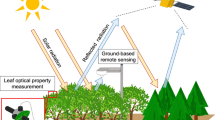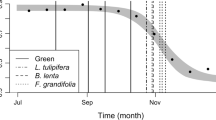Abstract
A broad regional understanding of tropical forest leaf photosynthesis has long been a goal for tropical forest ecologists, but it has remained elusive due to difficult canopy access and high species diversity. Here we develop an empirical model to predict sunlit, light-saturated, tropical leaf photosynthesis using leaf and simulated canopy spectra. To develop this model, we used partial least squares (PLS) analysis on three tropical forest datasets (159 species), two in Hawaii and one at the biosphere 2 laboratory (B2L). For each species, we measured light-saturated photosynthesis (A), light and CO2 saturated photosynthesis (A max), respiration (R), leaf transmittance and reflectance spectra (400–2,500 nm), leaf nitrogen, chlorophyll a and b, carotenoids, and leaf mass per area (LMA). The model best predicted A [r 2 = 0.74, root mean square error (RMSE) = 2.9 μmol m−2 s−1)] followed by R (r 2 = 0.48), and A max (r 2 = 0.47). We combined leaf reflectance and transmittance with a canopy radiative transfer model to simulate top-of-canopy reflectance and found that canopy spectra are a better predictor of A (RMSE = 2.5 ± 0.07 μmol m−2 s−1) than are leaf spectra. The results indicate the potential for this technique to be used with high-fidelity imaging spectrometers to remotely sense tropical forest canopy photosynthesis.








Similar content being viewed by others

References
Asner GP, Martin RE (2008) Spectral and chemical analysis of tropical forests: scaling from leaf to canopy levels. Remote Sens Environ 112:3958–3970
Asner GP, Nepstad D, Cardinot G, Ray D (2004) Drought stress and carbon uptake in an Amazon forest measured with spaceborne imaging spectroscopy. Proc Natl Acad Sci USA 101: 6039–6044
Asner GP, Martin RE, Ford AJ, Metcalfe DJ, Liddell MJ (2009) Leaf chemical and spectral diversity in Australian tropical forests. Ecol Appl 19:236–253
Baret F, Vanderbilt VC, Steven MD, Jacquemoud S (1994) Use of spectral analogy to evaluate canopy reflectance sensitivity to leaf optical-properties. Remote Sens Environ 48:253–260
Castro-Esau KL, Sanchez-Azofeifa GA, Rivard B, Wright SJ, Quesada M (2006) Variability in leaf optical properties of Mesoamerican trees and the potential for species classification. Am J Bot 93:517–530
Curran P (1989) Global change and remote-sensing. Int J Remote Sens 10:1459–1460
Dempster WF (1999) Biosphere 2 engineering design. Ecol Eng 13:31–42
Domingues TF, Martinelli LA, Ehleringer JR (2007) Ecophysiological traits of plant functional groups in forest and pasture ecosystems from eastern Amazonia, Brazil. Plant Ecol 193:101–112
Doughty CE, Goulden ML (2008) Are tropical forests near a high temperature threshold? J Geophys Res-Biogeosciences 113. doi: 10.1029/2007JG000632
Farquhar GD, Caemmerer SV, Berry JA (1980) A biochemical-model of photosynthetic Co2 assimilation in leaves of C-3 species. Planta 149:78–90
Feret JB et al (2008) PROSPECT-4 and 5: advances in the leaf optical properties model separating photosynthetic pigments. Remote Sens Environ 112:3030–3043
Field CB, Behrenfeld MJ, Randerson JT, Falkowski P (1998) Primary production of the biosphere: integrating terrestrial and oceanic components. Science 281:237–240
Gitelson AA, Merzlyak MN (1997) Remote estimation of chlorophyll content in higher plant leaves. Int J Remote Sens 18:2691–2697
Grace J, Lloyd J, McIntyre J, Miranda AC et al (1995) Carbon-dioxide uptake by an undisturbed tropical rain-forest in Southwest Amazonia, 1992 to 1993. Science 270:778–780
Green RO, Eastwood ML, Sarture CM et al (1998) Imaging spectroscopy and the airborne visible infrared imaging spectrometer (AVIRIS). Remote Sens Environ 65:227–248
Haaland DM, Thomas EV (1988) Partial least-squares methods for spectral analyses 1 relation to other quantitative calibration methods and the extraction of qualitative information. Anal Chem 60:1193–1202
Jacquemoud S, Baret F (1990) PROSPECT—a model of leaf optical-properties spectra. Remote Sens Environ 34:75–91
Kokaly RF (2001) Investigating a physical basis for spectroscopic estimates of leaf nitrogen concentration. Remote Sens Environ 75:153–161
Lee DW, Bone RA, Tarsis SL, Storch D (1990) Correlates of leaf optical-properties in tropical forest sun and extreme-shade plants. Am J Bot 77:370–380
Lichtenthaler HK, Buschmann C (2001) Chlorophylls and carotenoids: measurement and characterization by UVVIS spectroscopy. Current Protocols in Food Analytical Chemistry
McGroddy ME, Daufresne T, Hedin LO (2004) Scaling of C:N:P stoichiometry in forests worldwide: implications of terrestrial redfield-type ratios. Ecology 85:2390–2401
Myneni RB, Ross J, Asrar G (1989) A review on the theory of photon transport in leaf canopies. Agric For Meteorol 45:1–153
Phillips OL, Malhi Y, Higuchi N, Laurance WF et al (1998) Changes in the carbon balance of tropical forests: evidence from long-term plots. Science 282:439–442
Poorter L, Bongers F (2006) Leaf traits are good predictors of plant performance across 53 rain forest species. Ecology 87:1733–1743
Saleska SR, Miller SD, Matross DM, Goulden M et al (2003) Carbon in amazon forests: unexpected seasonal fluxes and disturbance-induced losses. Science 302:1554–1557
Sellers PJ (1985) Canopy reflectance, photosynthesis and transpiration. Int J Remote Sens 6:1335–1372
Sharkey TD, Bernacchi CJ, Farquhar GD, Singsaas EL (2007) Fitting photosynthetic carbon dioxide response curves for C-3 leaves. Plant Cell Environ 30:1035–1040
Sims DA, Gamon JA (2002) Relationships between leaf pigment content and spectral reflectance across a wide range of species, leaf structures and developmental stages. Remote Sens Environ 81:337–354
Sivak MN, Walker DA (1986) Photosynthesis invivo can be limited by phosphate supply. New Phytol 102:499–512
Smith ML, Martin ME, Plourde L, Ollinger SV (2003a) Analysis of hyperspectral data for estimation of temperate forest canopy nitrogen concentration: comparison between an airborne (AVIRIS) and a spaceborne (Hyperion) sensor. IEEE Trans Geosci Remote Sens 41:1332–1337
Smith WK, Kelly RD, Welker JM, Fahnestock JT, Reiners WA, Hunt ER (2003b) Leaf-to-aircraft measurements of net CO2 exchange in a sagebrush steppe ecosystem. J Geophys Res-Atmospheres 108(D3):15.1–15.9
Townsend AR, Cleveland CC, Asner GP, Bustamante MMC (2007) Controls over foliar N:P ratios in tropical rain forests. Ecology 88:107–118
Verma PK (1993) Remote-Sensing. Curr Sci 64:146–147
Wright IJ et al (2004) The worldwide leaf economics spectrum. Nature 428:821–827
Acknowledgments
We thank K. Kinney, J. Kellner, and E. Broadbent for help in the field, and C. Field for advice. This work is funded by a Carnegie Institution fellowship, the NASA Terrestrial Ecology Biodiversity Program, and the John D. and Catherine T. MacArthur Foundation.
Author information
Authors and Affiliations
Corresponding author
Additional information
Communicated by Gerardo Avalos.
Electronic supplementary material
Below is the link to the electronic supplementary material.
Rights and permissions
About this article
Cite this article
Doughty, C.E., Asner, G.P. & Martin, R.E. Predicting tropical plant physiology from leaf and canopy spectroscopy. Oecologia 165, 289–299 (2011). https://doi.org/10.1007/s00442-010-1800-4
Received:
Accepted:
Published:
Issue Date:
DOI: https://doi.org/10.1007/s00442-010-1800-4



